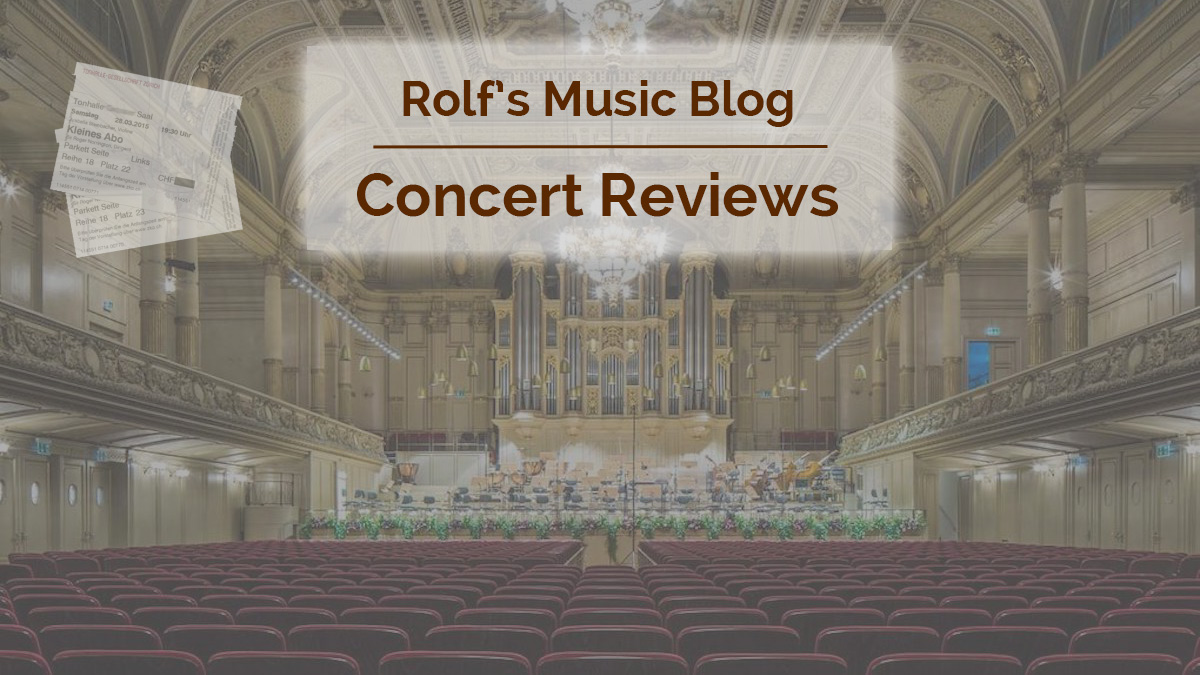David Zinman / Tonhalle Orchestra Zurich
Gustav Mahler: Symphony No.6, “Tragic”
Tonhalle Zurich, 2017-03-03

2017-03-08 — Original posting
Introduction
This is the last concert season in the Zurich Tonhalle prior to its closure for thee years, for a thorough renovation / overhaul (backstage) and restoration (concert halls). David Zinman (*1936, see also Wikipedia for information) who has led the Tonhalle Orchestra Zurich as chief conductor for many years up till 2014, has returned for a visit as lifetime honorary conductor, to conduct Mahler’s Symphony No.6; this was the first one of three successive concerts—this one specifically for sponsors and donors, the other two were subscription concerts. Mahler’s symphony asks for a huge orchestra, and so, the extended podium reached out well into the parquet of the venue.
Mahler: Symphony No.6 in A minor, “Tragic”
The following information is from Hans F. Redlich‘s foreword to the Eulenburg pocket score (see the addendum 3 at the bottom of this post).
Gustav Mahler (1860 – 1911) completed the composition of his Symphony No.6 in September 1904—a time which he and his wife Alma Mahler (1879 – 1964) considered very happy years. But already back then Mahler stated that this symphony would be a mystery to the listeners, unless they heard and understood all of his previous symphonies. The symphony has four movements—listed here in the sequence played in this concert (see below for details):
- Allegro energico, ma non troppo. Heftig aber markig
- Andante moderato
- Scherzo. Wuchtig
- Finale. Allegro moderato – Allegro energico
Tragic?
One can certainly see a mystery in the last movement, with its rather fatal ending. Mahler himself used the term “Tragic” in connection with this symphony, particularly the last movement. Later, Alma Mahler interpreted that movement—in particular, its three ominous hammer beats—as anticipation of their “catastrophic summer 1907”. That year, they lost their elder daughter, and Mahler himself received the fatal diagnosis about his heart disease. In that same year, Mahler lost his position at the Vienna State Opera, due to intrigues.
Somehow, this attribute “tragic” stuck with the symphony, and I suspect that this may have contributed to the fact that the symphony fell out of the popularity. It was first performed in 1906 in Essen / Germany, and in the following concert season, there were performances in Munich, Leipzig, and in Dresden. However, thereafter it was not performed till after Mahler’s death (1911). In the US, the first performance happened only in 1947. There were also times when the symphony was derided as “the symphony with the hammer”. Luckily, the reputation of that composition appears to have improved lately.
Tragic Even Throughout?
Some musicologists appear to be looking for aspects of tragedy also in the other movements of the symphony No.6: arguments put forward include specific harmonic sequences (e.g., A minor chords after A major). Even the program notes for the concert talk about pitch black negativity. At the same time, people realize that the symphony was composed in a period which both the composer and his wife regarded as very happy: around that time, Alma gave birth to two daughters.
To me, the key question is whether it is justified to call a symphony “tragic” (and hereby risk giving the symphony a bad reputation), even if this essentially only applies to the last movement? To me, one should rather judge a symphony based on how it “works” as a whole: as a listener (i.e., without analyzing the score theoretically, and without focusing on individual, singular chord sequences), I don’t find this symphony (the last movement excepted) overly tragic. I further think that one could find “tragic” moments and aspects in most of Mahler’s symphonies
In the years 2006 – 2010, David Zinman has recorded all of Mahler’s symphonies with the Tonhalle Orchestra orchestra. I think it is not just coincidence that for his visit to Zurich (three years after his contract as chief conductor ended) selected this symphony. Maybe it even is his favorite symphony by this composer?
The Performance
David Zinman is of course thoroughly familiar with this music. His conducting is very clear, his gestures precise. And the orchestra knows exactly how to react to Zinman’s direction. I found the orchestra to be entirely focused on the performance: its playing definitely was at the level of quality and presence that resulted from the 19 years of Zinman’s work with the ensemble. The orchestra sound is clear and transparent, and the coordination excellent. The dynamic span very impressive—but of course, with an ensemble of that size, that is to be expected. I also found the string sound to be dense and homogeneous.
I. Allegro energico, ma non troppo. Heftig aber markig
Yes: the first movement starts with martial march rhythms, the atmosphere is earnest, at least initially. Zinman and the orchestra were excellent at forming build-ups, carefully shaping transitions, and at letting the melodies flow. Ah, those wonderful cantilenas: they set in soon after the martial beginning, and later, they are allowed to flourish extensively, especially in the violins. Despite the earnest moments / segments, in my opinion, the movement is dominated by these flowing melodies. I enjoyed marvelous, lucid, even serene, if not even playful music.
The way I experienced it, the tragic aspect remains episodic in this piece. It is possible, though, that the events, the history of the 20th century, or even just the music since Mahler have fundamentally shaped, altered my/the listener’s perception of music in general. In other words: it is possible that listeners at Mahler’s time had an entirely different view on what “sounds tragic”, and what doesn’t. Therefore, listeners art the beginning of the 20th century may have had a stronger perception of tragedy in this music.
II. Andante moderato
David Zinman took the Andante moderato as second movement. In the course of his revisions, Mahler himself tried both the Scherzo, as well as the slow movement as second movement. In the final version of the score, the Scherzo is the second movement, i.e., the inner movements are exchanged compared to what we heard in this concert. I think both options can be justified—and be it only because the composer appeared to be in doubt about the “proper” solution. The argument for Zinman’s option could be that after the opening movement, one takes a slow start with the Andante moderato, then builds up across the Scherzo, up to the final movement. The other option (Andante moderato as third movement) allows the listener (and the musicians) to “take a rest” prior to the tragedy of the monstrous last movement (which may then have a bigger effect).
In the concert, however, the Andante moderato immediately stopped such considerations. It captured the listener’s mind and heart with its sad, melancholic, longing melodies, and with its calm, waiting atmosphere. There are sounds of nature, cow bells are sounding from a distance. The melodies feel like relaxed singing, immersing in soothing memories, fading away into transfiguration. Only momentarily, the texture gets denser, the music more dramatic—but that’s merely a short episode.
III. Scherzo. Wuchtig
In Zinman’s interpretation, the Scherzo appeared rhythmically well-structured, tempo changes were clear, performed diligently, following a clear concept. In classic times, the middle part would be a Trio—here, that part is not so distinctly separated from the outer parts (Scherzo). It alternates between contemplative and almost menacing atmosphere. At times the movement almost appears to come to a halt, hesitating; on the other hand, there are also episodes with almost folksy atmosphere.
IV. Finale. Allegro moderato – Allegro energico
The final movement is almost monstrous, with its duration of about 30 minutes. Here now, the music indeed is tragic, the atmosphere turns eery, scary; night scenes with music suited as film music (from today’s perspective, of course). But despite all the tragedy, there are folksy and march-like episodes that build up to almost over-excited exuberance. In Mahler’s view, the symphony culminates in the three famous, ominous, “catastrophic” hammer beats in the last part of the movement (and according to Alma Mahler, the last beat is the most catastrophic, the deadly one).
How to Realize the Hammer Beats?
Mahler wanted the “Hammer” to make a very loud, “terrible”, dull, non-metallic sound—presumably something like an axe on an executioner’s block. Orchestras have apparently been struggling with finding suitable solutions. Most often, a wooden hammer is used, beaten upon a wooden block or a box-like structure. The Web has videos showing adjacent musicians momentarily shielding their ears, closing their eyes, etc., while the hammer is in use. Work safety is indeed a concern with such an “instrument”—and it conflicts with Mahler’s intent for the hammer to have a terrifying effect on the listener.
In Zurich, the hammer indeed was monstrous. The hammer-head had a diameter of some 25 cm and a length of 50 – 60 cm. The “target” was not visible from the parquet seating. The “hammer man” was a percussionist in the rear left corner of the podium. Despite the dimensions of the hammer, its effect remained in limits. The sound of the large orchestral apparatus almost covered the sound of the hammer strokes (a strong beat on the big drum was louder than the hammer). The effect more visual than auditive—and in my opinion not frightening, catastrophic enough. If one was not looking into that direction, one might even have missed one or the other hammer beat.
The Last Movement, Overall
Even with the limitations of how the hammer beats were performed and realized, the intended effect of these three tragic climaxes could still be felt, perceived in the audience. One might even claim that the actual hammer beats aren’t that much of an indispensable ingredient: the music itself carries these fatal culminating points. However, in Mahler’s score, these really are merely culminating points in dramatic build-ups, their effect in the music doesn’t really last very long. After the first hammer stroke, the listener finds him/herself in a pleasurable, almost idyllic scenery.
Yet, Mahler asks for two more hammer strokes—consequently following a fatal pull into a fatal abyss. In its last part, the music shows aspects of a scary panopticon of horrors, with shrill, glaring sounds. Yet, even in its extreme, tragic moments, I still found the music to be aesthetically pleasing as a composition, as well as in the interpretation, excellently performed.
Summary / Conclusion
With the exception of a few segments in the last movement, Mahler’s music in this concert never went overboard, it remained aesthetically controlled. The one point that one might (mildly) criticize about David Zinman’s interpretation is that it could have dared going farther in risking loss of emotional control. In its instrumental perfection, to me, it remained a tad too controlled. One aspect that I really like about Mahler’s music is exactly in its fantastic, sometimes demonic aspects—facets which an excess of control can defeat.
Nevertheless: overall, this concert was definitely an impressive experience. Mahler’s music did not fail on me: the concert reminded me of the richness and the beauty of this music!
Addendum 1
David Zinman has recorded Mahler’s Symphony No.6 with the Tonhalle Orchestra Zurich:
Gustav Mahler: Symphony No.6 in A minor, “Tragic”
David Zinman, Tonhalle Orchestra Zurich
RCA Red Seal / Sony BMG 88697 36465 2 (2 CDs, stereo); ℗ / © 2008
Booklet: 32 pp. de/en/fr

Addendum 2
I use the Eulenburg pocket score while listening to this symphony: —Find pocket score on amazon.com (#ad) —
Addendum 3
For the same concert, I have also written a (shorter) review in German for Bachtrack.com. This posting is not a translation of that German review, the rights of which remain with Bachtrack. I create the German review using a subset of the notes taken during this concert. I wanted to enable my non-German speaking readers to read about my concert experience as well. Therefore, I have taken my original notes as a loose basis for this separate posting. I’m including additional material that is not present in the Bachtrack review.





